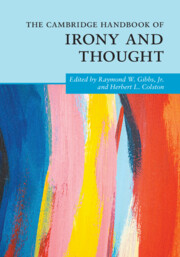Book contents
- The Cambridge Handbook of Irony and Thought
- Cambridge Handbooks in Psychology
- The Cambridge Handbook of Irony and Thought
- Copyright page
- Contents
- Contributors
- Part I Introduction
- Part II The Scope of Irony
- Part III Irony’s Impact
- Part IV Irony in Linguistic Communication
- 8 Constructions in Verbal Irony Production: The Case of Rhetorical Questions
- 9 Tracking the Ironical Eye: Eye Tracking Studies on Irony and Sarcasm
- 10 Inferring Irony Online
- 11 Irony and Thought: Developmental Insights
- 12 Vocal Strategies in Verbal Irony
- 13 Great Expectations and EPIC Fails: A Computational Perspective on Irony and Sarcasm
- Part V Irony, Affect, and Related Figures
- Part VI Irony in Expressive, Nonlinguistic Media
- Index
- References
13 - Great Expectations and EPIC Fails: A Computational Perspective on Irony and Sarcasm
from Part IV - Irony in Linguistic Communication
Published online by Cambridge University Press: 20 December 2023
- The Cambridge Handbook of Irony and Thought
- Cambridge Handbooks in Psychology
- The Cambridge Handbook of Irony and Thought
- Copyright page
- Contents
- Contributors
- Part I Introduction
- Part II The Scope of Irony
- Part III Irony’s Impact
- Part IV Irony in Linguistic Communication
- 8 Constructions in Verbal Irony Production: The Case of Rhetorical Questions
- 9 Tracking the Ironical Eye: Eye Tracking Studies on Irony and Sarcasm
- 10 Inferring Irony Online
- 11 Irony and Thought: Developmental Insights
- 12 Vocal Strategies in Verbal Irony
- 13 Great Expectations and EPIC Fails: A Computational Perspective on Irony and Sarcasm
- Part V Irony, Affect, and Related Figures
- Part VI Irony in Expressive, Nonlinguistic Media
- Index
- References
Summary
We typically believe that irony is a completely human affair, but there have been interesting attempts to create computational models of irony use and understanding. This chapter presents an overview of some of these models, especially as implemented as conversational agents. One of the beauties, and major challenges, of computer modeling is that it forces researchers to make concrete decisions on how best to implement some linguistic observation or theoretical idea (e.g., how to create a workable model of echoic mention, pretense, or what is meant by incongruity). Veale presents his EPIC model in which an expectation (E) predicts a property (P) of an instance (I) of concept (C) that can get upended by an ironic utterance. This model provides a quantifiable view of what it means for an ironic utterance to achieve its desired effect on an audience. The success of an ironic utterance hinges on its capacity to highlight the failure of a reasonable expectation. The effectiveness of this computational model was partly assessed by obtaining human judgments about the meaning and quality of different ironic utterances in varying contexts that are suggestive of different expectations. In this way, Veale’s work offers insights as to how engineering solutions may be very informative about the way irony functions in human communication.
Keywords
- Type
- Chapter
- Information
- The Cambridge Handbook of Irony and Thought , pp. 216 - 234Publisher: Cambridge University PressPrint publication year: 2023



